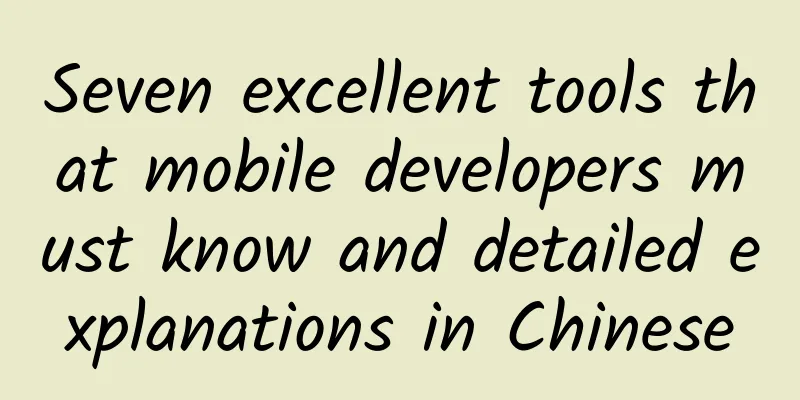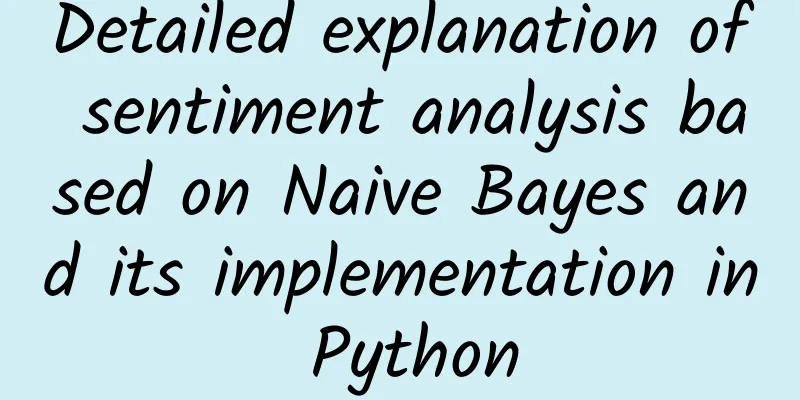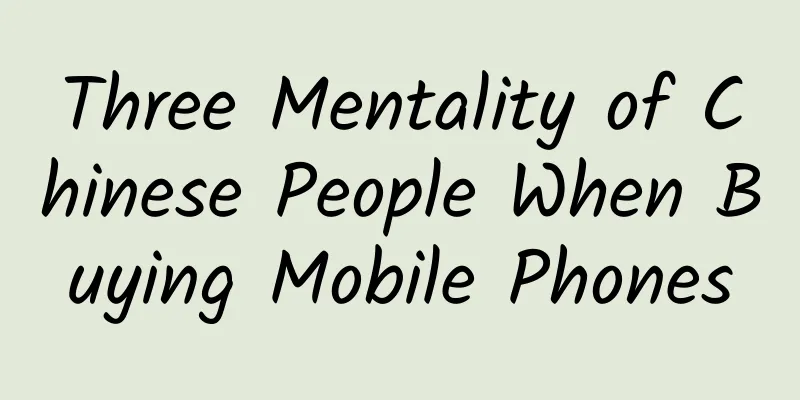Seven excellent tools that mobile developers must know and detailed explanations in Chinese

|
The low-coding mobile development tool camp represented by Alpha Anywhere, AnyPresence and Salesforce 1 is booming. Over the past six months, I have been looking at and testing different types of mobile app building tools and mobile backends. In some cases, these app building tools and backends are part of a single product; in other cases, these app building tools or backends serve users as standalone products. In this review, I will summarize the seven products that are at least some kind of mobile application building tools. Some of them provide IDEs that run locally on the user's computer, while others use cloud-based Web IDE solutions. Some development tools are specifically aimed at the enterprise field, and some are more suitable for individual developers or even programming learners. As you will see below, these app building tools can meet almost any developer's complexity requirements. From simple drag-and-drop operations such as EachScape, NSB/AppStudio, and Ssalesforce 1, to providing APIs directly to developers, to Appcelerator providing native SDK developers with code in Xcode or Eclipse, it can be said to be all-encompassing. These tools are suitable for mobile web, mobile hybrid or native applications on Android and iOS platforms, and even relatively niche mobile system platforms such as Windows Phone are included in the support list. These tools often integrate one or more mobile security products. For example, AnyPresence can easily implement user application security with Apperian. Some tools are tied to MBaaS (Mobile Backend as a Service), but some are not. They may or may not be able to consume and modify data from the system of record. If they have this capability, such tools may require developers to write RESTful interfaces for them or handle the relevant connection tasks themselves. Such tools may use offline/online data synchronization mechanisms to effectively reduce the difficulty of supporting offline mobile operations, while tools such as Alpha Anywhere provide users with a complete documentation to solve various problems, or prepare a set of components with a Swedish instruction manual - sorry, this is the IKEA routine, but the basic idea is exactly the same. In addition to the extreme cases mentioned above, these construction tools may provide a framework that can complete some of the work, but leave the rest to the user and require everyone to complete it completely with code or forms. If these build tools support HTML 5 apps, they may or may not support our favorite JavaScript frameworks. If they are primarily for native or hybrid apps, they may have their own online app building service, integrate with PhoneGap Build, or require users to build apps themselves using a native SDK on their development device. These build tools range in price from $99 per developer to "a little over $100k per company per year." In most cases, I find the pricing to be very reasonable and a good value for the right audience. However, students can't benefit from enterprise-level app builders and MBaaS, and enterprise developers certainly can't use app builders without any integration capabilities to complete their daily work. In short, these seven products range in scope and complexity, and no single product will satisfy all user needs. With that in mind, I'll focus on highlighting which types of developers and designers each app building tool is well suited to supporting. Get started with the full review... Alpha Anywhere Alpha Anywhere is a database-oriented rapid development tool that allows developers and designers to create web and hybrid mobile applications that can run offline. It allows less experienced developers to combine various configurable components, visual design tools, code generation "wizards" and a small amount of Xbasic or JavaScript code to create their own highly complex applications. Alpha Anywhere IDE runs in Windows environment. The tool targets iOS, Android, Windows Phone and other mobile and desktop clients with HTML 5 compatible web browsers. Alpha Five is a web and desktop application development tool that features an application and web server, a PDF report generator, and strong support for dozens of SQL and desktop database solutions. Alpha Five is the successor to Alpha Four, an easy-to-use dBase clone. Alpha Anywhere is an extension of Alpha Five that combines mobile web and hybrid mobile application development with a host of Alpha Five practical techniques, including the recently added offline support, offline-online data synchronization, and intelligent data conflict resolution. Alpha Software's folks took into account the real-world problems that mobile devices face in most real-world scenarios - such as using, modifying, and generating server data when the network connection is unstable - and reduced the number of choices developers need to make when checking a device. To design a mobile UI using Alpha Anywhere, you usually need to drag panels, containers, and controls in the tree view of the UX (user experience) component and set properties for each element. Although it cannot be compared with those true WYSIWYG design tools, Alpha Anywhere's development solution can greatly improve the efficiency of application construction. We can view the preview of the application in operation or idle state at any time, and as long as there is enough screen space, we can also view multiple view interfaces at the same time. The server-side Xbasic of the Alpha Web or mobile component is responsible for generating HTML 5 and JavaScript code and delivering it to the browser for rendering. Now let's look at the downside. Alpha IDE and application server currently only run on Windows; Alpha's application server is proprietary; Alpha lacks scalable cloud services as a companion; Alpha lacks native mobile client support. Developers can work around Alpha's lack of native iOS and Android code generation by integrating PhoneGap, and in fact, Alpha Anywhere mobile components and controls already provide a look and feel similar to native apps. Overall, I think Alpha Anywhere is a very good web, mobile web and mobile hybrid development system. Its IDE is very powerful and easy to use, but its features are a bit too rich and people may forget where to find the corresponding project they really need. Its features and integration level are worthy of high praise. Alpha has its own JavaScript client framework, which includes support for jQuery, but younger frameworks like Angular and Backbone are not yet supported. On the other hand, Alpha's templating language is very similar in style to Angular, and we have no complaints about the framework itself - the system generates almost all the code we need. Enterprises looking to create mobile applications using SQL and REST data sources will benefit greatly from Alpha Anywhere, especially when ease of use and time to market are key drivers. Alpha's handling of offline mobile operations, offline-online data synchronization, and intelligent data conflict resolution mechanisms put enterprises in an ideal development hotspot where they don't have to worry too much about these important challenges. AnyPresence As an online mobile application building tool and backend service, AnyPresence combines a wide range of client support capabilities, a very practical code generation mechanism, and rich functional options for data storage and enterprise integration. Although I initially thought that AnyPresence should be evaluated using MBaaS standards (in the review at the time, it received a score of 9.1 and an Editor's Choice Award), it is undeniable that it is also an excellent application building tool. AnyPresence can build applications, backend services, and API gateways. It has an online design tool that can not only generate backend and mobile application code, but also provide customized mobile API code. All generated code can be downloaded, edited, and run on compatible platforms. For example - and this is the most proud example of AnyPresence - Mastercard uses AnyPresence to help its partners more easily build mobile applications for Mastercard's Open API service. AnyPresence generates app UIs for jQuery, Android (XML layouts), and iOS (storyboards) (or starter kits if you prefer), and app SDKs for Java, Android, HTML 5, Windows Phone, Xamarin, and iOS. It generates backend servers for Ruby on Rails and Node.js. AnyPresence environments can generate deployments for Heroku (usually as a backend), Amazon S3 (usually for HTML 5 apps), and native iOS and Android apps, with Apperian security features for developers to choose from. The AnyPresence app building options screen. Note that there are multiple SDK types that can be generated, allowing developers to prototype a small number of app UI scenarios. The AnyPresence design environment is available online and runs in most browsers. In addition to the interface design tool, it also provides dashboards; settings screens; screens for creating and monitoring environments, deployments, and builds; screens for generating and deploying applications, backends, and SDKs; screens for adding and managing data sources and data objects; screens for adjusting authentication, role, and authentication policies; screens for preparing and customizing extensions, plus a set of customizable themes. I found the data source options in AnyPresence to be excellent and deliver MongoDB data stores in a manner that is on par with other MBaaS systems. What really sets AnyPresence apart is the unique way it generates data models in the design environment and in all generated code. The only other app building tool that comes close in this regard is Alpha Anywhere, which uses a SQL database as its backend data store. Although AnyPresence lacks its own monitoring service, it can integrate with third-party services such as Airbrake and New Relic. AnyPresence is priced higher than most other competitors, but it is still more cost-effective for enterprise customers who need to integrate existing systems with mobile applications. This is obviously more important for enterprise customers who want to provide their own APIs to partners for mobile application building. #p# Appcelerator Appcelerator Titanium has been in the mobile development space for years, and its JavaScript-based development environment compiles native code to code that runs on iOS, Android, and other target platforms. With the release of Appcelerator Studio 3.3 and Appcelerator Platform 2.0 in July 2014, the company added a set of MBaaS and about 25 related APIs, Node.js support, and online analytics. In addition, Appcelerator has released multiple interfaces for its MBaaS, which developers can add to their applications using the native SDK - but Appcelerator's own Studio IDE still does not support the native SDK. Similar to AnyPresence, I originally reviewed Appcelerator as an MBaaS, but it is also a great app building tool with a great IDE. Appcelerator has multiple frameworks in the client and provides multiple API types for cloud platforms. From the client-side basic level, Appcelerator provides Titanium SDK, which can provide an interface between JavaScript and native services. From a high-level perspective, Appcelerator provides Alloy framework, which is based on the model-view-controller architecture and has built-in support for Backbone.js and Underscore.js. When you use Studio to create a new client application, we usually use Alloy to complete the code generation. On the cloud platform side, you can use Appcelerator Cloud Services in a variety of ways using the REST API, including through the Titanium SDK bundle, through Node.ACS, and through the native SDK. The REST API will always work, but it is at least the most convenient option. Often you will want to use REST calls to use new services that are not yet bundled with the Titanium SDK. Appcelerator Studio's application configuration screen. Appcelerator can call REST and even SOAP services using HTTPClient and its built-in parsing procedures. If you have set up a REST wrapper for database queries, it will be easy to bring JSON data into your application. After extending a web service to a database server, this wrapper may also work for Node.js or other servers. Currently, a more formal MBaaS solution is being tested, which uses integrated modules to set up and easily map to various mainstream databases used by its applications, including Oracle, SQL Server, MySQL, PostgreSQL, etc. Although writing RESTful database packaging tools is not a difficult technology, especially in the Node.js environment, Appcelerator's ability can still save developers a lot of valuable time. Appcelerator says it has built several enterprise connectors for the MBaaS layer, including SAP and Salesforce.com, and one of Node's inherent strengths is that it offers community-developed modules for other data sources, such as MySQL, SQL Server (which runs on Windows Server with Node.js installed), PostgreSQL, and other NoSQL databases. Similarly, Appcelerator can use a local SQLite database on the device, work with peer storage, provide in-memory caching mechanisms, and recognize when a device is online. However, it does not provide a complete framework for dealing with intermittently connected applications, especially not resolving such conflicts. According to the company, most of its customers choose to use the Alloy model to handle these issues. Appery.io Appery.io is a cloud-based mobile web and hybrid mobile development platform that provides online visual video and programming tools as well as integrated backend services. You can think of it as a crossover solution between application building tools and MBaaS. The Appery.io app builder generates HTML 5, jQuery Mobile, AngularJS, Bootstrap, and Apache Cordova code, while its Appery.io build server generates iOS, Android, Windows Phone, and HTML 5 apps. Its Appery.io MBaaS offers hosting, MongoDB databases, push notifications, JavaScript server code, and a secure proxy. It can host HTML code in its own cloud, on Heroku, and (manually) at a third-party hosting provider. The Appery.io app builder provides tabs for app settings, build mode and storage, created pages, dialogs, templates, themes, CSS, all defined services, JavaScript, and any custom components. The builder uses a WYSIWYG design mechanism, with a dashboard that includes more than 25 controls, including external services such as Google Maps and Vimeo, and displays a property sheet for each item. You can switch between design view and source code view to see the HTML, CSS, JavaScript, and other code you wrote for the device: Java for Android, Objective-C for iOS, and C#-based XAML for Windows Phone. Appery.io provides a drag-and-drop page design tool. The platform can automatically generate source code and make it available for everyone to view online. If we are satisfied with our development results, we can export them to mobile web and mobile hybrid targets, including application binaries. Appery.io can basically connect to any REST API, regardless of whether the company provides a pre-made interface or not. Connecting a pre-made REST interface to a service only takes a few minutes; building a REST interface from scratch takes a little longer and requires a certain level of developer skill, but overall the workload is not that large. You can test your HTML 5 app as you develop it, either in a desktop browser or on your phone or tablet's browser; all without relying on Cordova. To test your Cordova code (for example, to exploit native device features or get push notifications), you just build the app, download it to your device, and run it. For your convenience, Appery.io displays a QR code and binary for our HTML 5 app so you can download it directly on your device. For even more convenience, you can also install the Appery.io Native Test App shell on your device and point it to your development code. Overall, I found the Appery.io app building tool easy to learn and use. Appery.io has done a great job in designing the IDE so that mobile developers can get an amazing experience. It is also worth mentioning that Appery.io has its own cloud-based build tools and build services. When combined with the browser-based IDE, this means that mobile developers no longer need to use multiple computers or multiple virtual machine systems to create native applications, nor do they need to maintain multiple native SDKs and IDEs for this purpose. EachScape EachScape has done a great hat trick in generating iOS, Android and Web applications using an online drag-and-drop design tool. In addition, EachScape uses its platform to provide mobile backend services for the applications you build, web previews for all applications, and online build services. EachScape's excellent architecture enables it to build iOS, Android and HTML 5 applications based on blocks and modules, layouts and actions through a drag-and-drop editor (i.e. Cloud Studio). From a bottom-level perspective, EachScape implements a series of Objective-C classes for iOS and a collection of Java classes for Android. In CoffeeScript for web applications, it covers ads, buttons, containers, controls, data connectors, data input, HTML, images, maps, media, navigation, placeholders, RESTful remote queries, social networks and text, etc. High-level developers can build new functional blocks and modules for EachScape, thereby using its SDK to expand functionality. In EachScape Web Studio, you can drag and drop functional blocks and configure them to create application results. EachScape backend services include Cloud Collections (explained later), data connectors, analytics, mobile advertising, social media access, push notifications, location services, and billing. EachScape currently does not offer other backend services outside of the platform subscription. EachScape Cloud Studio has a Microsoft Visual Basic/Borland Delphi-like development paradigm. Specifically, drag a function block to a page in the application, set its visual position and configure properties. View a web preview solution, manipulate and iterate on it. You can also use a cloud data set or other data sources to populate data into the application. When you're ready to test your app on a device or simulator, build your app online and check your target platforms - various Android versions, iOS 7 and 8, and HTML 5. Once you've selected your build target in the EachScape cloud (which takes a few minutes, especially if it's your first time building for a specific platform), you can download your app to a device or simulator to test it. The build history screen provides a QR code to help you more smoothly download your app to your device. EachScape's Cloud Collection functionality is somewhat similar to the MongoDB implementation on most MBaaS platforms, and the implementation of Confucius CMS in WordPress is quite similar. EachScape data connectors are often limited to RESTful XML, RSS, and JSON data sources. EachScape does not currently provide any RESTful package creation mechanism related to the system of record. According to the company, such tools will be available to the general public in the second quarter of 2015. #p# NSB/AppStudio NSB/AppStudio is aimed at both mobile web and mobile hybrid applications. Its AppStudio IDE is written in JavaScript, HTML 5 and WebKit, and it can run on Windows and Mac OS X platforms. This tool combines the advantages of easy learning, ease of use, and free distribution. This low cost of use helps AppStudio bring mobile web and hybrid development capabilities to a large number of users. In addition, NSB/AppStudio also inherits the characteristics of Visual Basic and other early Borland visual programming tools in spirit. You can build your own mobile application by dragging and dropping forms and controls, and write code using NS Basic - essentially VBScript with some extensions - or JavaScript. When the application is published or run, no matter whether it is developed locally or deployed on a server, any Basic script can be translated into JavaScript code. You can display JavaScript code as any form through the IDE. In the AppStudio IDE, you can use form controls, toolboxes, project explorers, property sheets, and help windows, all in line with Visual Basic and its successors and imitators. The IDE cannot debug itself, but you can solve this problem using the browser in a PhoneGap application or the weinre remote debugging tool in a web page. NSB/AppStudio is a drag-and-drop IDE for mobile web and mobile hybrid application development, and it highly inherits the design ideas of Microsoft Visual Basic. Please note that its design tools, toolbox, project explorer, property sheet and help window are highly consistent with Visual Basic. Right-clicking a control brings up a context-sensitive menu that lets you create event handlers, add components, and adjust the current layout. The component selection is impressive, with nearly 60 controls ranging from simple labels to complex widgets and interfaces, financial services, and social media. AppStudio allows you to build mobile web apps and mobile hybrid apps; the latter requires PhoneGap. AppStudio also provides more than a hundred sample scenarios, ranging from "hello, world" to using all included controls, and provides about thirty web services and more than a dozen third-party JavaScript libraries. AppStudio NSBasic mobile web and hybrid applications have excellent performance levels, and its JavaScript code performance is basically consistent with other mobile web application building tools. If you are just starting to work on mobile development and have no prior programming knowledge, NSB/AppStudio is undoubtedly a great tool to start with. However, it should be noted that compared with other full-featured mobile IDEs and MBaaS platforms, its number of features is relatively limited, and it usually lacks native mobile application support and enterprise integration capabilities. Salesforce 1 Over the past few years, Salesforce.com, a leading SaaS platform for sales force automation and other business applications, has developed its mobile strategy for a variety of development difficulty levels, ranging from minimal control to high-level control. Starting with the simplest option, the Salesforce 1 toolkit includes a Web-based drag-and-drop design tool for enterprise analytics. It allows analysts to customize applications, control security and access mechanisms, and streamline workflows using records from mobile devices. Although the Salesforce 1 design tool is not very difficult to use on the surface, it still provides excellent price-performance ratio. In the process of use, you can configure a set of custom procedures in the cloud database as a service, which has strong security, role-based permission management, and automatic REST API endpoint usage mechanism. The application developed in this way can access any content. You should connect to Salesforce through XML Web services, and Salesforce can generate the appropriate WSDL for your custom procedures. At a further level of complexity, web developers with some expertise in HTML 5, CSS3, and JavaScript can build pages for Salesforce 1 in Visual Force using Mobile Pack or Linghtning components. At the highest level of complexity, mobile developers can use Salesforce data to build native or hybrid apps for iOS or Android platforms using the Salesforce Mobile SDK. At the same time, every developer can use the mobile backend services provided by the Salesforce 1 Platform. The Salesforce 1 setup screen is a new part of the Force.com home screen for developers. As you can see, it shows a quick start wizard, multiple options for customizing the app, security and access control mechanisms, and multiple ways to use records on mobile devices. Salesforce also offers free Salesforce 1 native mobile shell applications for iOS and Android that users can download from the appropriate storage location and use to view Salesforce 1 Web content. These hybrid applications can take advantage of the various benefits of Web applications, such as retaining state after background switching and supporting secure offline reading after data is loaded. The Salesforce 1 Windows Phone application has been released, but the specific launch date has not yet been finalized. In addition to providing mobile development solutions for developers of different levels, Salesforce also prepares a variety of back-end development mechanisms for developers of different levels. For beginners and business analysts, the best option is undoubtedly to click to declare Force.com logic. For developers familiar with Java, Apex coding is relatively easy to learn. Developers who understand SQL Select statements and SOQL (Salesforce Object Query Language) can easily query Salesforce objects. For full-text search, SOSL (Salesforce Object Search Language) allows everyone to search Salesforce text, email, and phone fields for multiple objects at the same time. Finally, to further enhance your flexibility, you can also connect Salesforce to Heroku and use open source languages for server programming. Suitable for mobile development needs Alpha Anywhere is ideal for consultants and enterprise developers who want to build mobile web and hybrid applications for a variety of enterprise needs, especially those that rely on data from a central SQL database. Alpha's support for offline mobile operations, offline/online data synchronization, and conflict resolution is excellent. AnyPresence is for enterprise developers who want to create mobile APIs and make their services accessible to departments and partner ecosystems. As an Editors' Choice winner and top scorer, AnyPresence is our top pick in this comprehensive review, but its relatively high price tag makes it more suitable for large enterprises that use mobile technology extensively. Appcelerator Titanium is perfect for JavaScript developers who want to build native applications but don't want to write Java, Objective-C, or Swift code. It is especially suitable for those who prefer Backbone-like JavaScript frameworks and Node.js. Appery.io is ideal for enterprise designers and developers who want to build their own mobile web and hybrid applications in the cloud environment and do not need native applications. It also excels in the convenience of connecting to REST services. EachScape is ideal for consultants, enterprise designers, and developers who want to build their own native iOS, native Android, and mobile web applications in a cloud environment. It integrates well with REST services. NSB/AppStudio is very suitable for students and consultants who are familiar with Basic language and Visual Basic drag-and-drop paradigm and want to build mobile web and hybrid applications. Its main advantage lies in convenience and ease of use. Salesforce1 is very suitable for enterprise customers who are already using Salesforce solutions and want to expand mobile device access to Salesforce applications and databases. It provides a variety of development options suitable for different skill levels, including online drag-and-drop configuration mechanisms for business analysts and native SDK support for mobile development experts. If you are already using Salesforce solutions, you can use it for free. However, if you are not using Salesforce solutions and only need to use it to build mobile applications, the cost of this solution is a bit expensive. Alpha Anywhere 3.0 / Alpha Software Overall Overview Alpha Anywhere 3 is a RAD (rapid application development) tool that allows developers to quickly build Web, mobile Web, and hybrid mobile applications while providing excellent online/offline data synchronization management support capabilities. Advantages Rapid development capabilities for mobile web, hybrid mobile, web, and desktop applications. Excellent database integration effect. Excellent design and implementation support for offline mobile operations, and data conflict resolution mechanism. Alpha Anywhere allows less experienced developers to create applications of higher complexity. shortcoming The Alpha IDE and application server currently only run on Windows. Although IIS support is in beta, its application server remains a dedicated solution for the time being. The Alpha Anywhere cloud service is still in the beta testing phase. AnyPresence/AnyPresencedirectup Overall Overview AnyPresence is a mobile application platform for enterprises, not just MBaaS. It includes a very practical code generation mechanism and API gateway. Advantages Powerful MBaaS service with enterprise function integration and data storage capabilities. Provides online design tools and object modeling mechanisms. Able to support multiple mobile application target platforms and provide Rails backend. Generate customized API based on design objects. All generated codes are portable and downloadable. shortcoming There is currently no support for Node.js backends, but this capability is in the planning stages. It does not provide a monitoring mechanism itself, but can be integrated with third-party monitoring and log processing systems such as New Relic, Airbrake, and Splunk. Appcelerator Platform 2.0.0/Appceleratordirectup Overall Overview Appcelerator is a great app building tool with a great IDE, but it lacks a full framework for handling intermittently connected apps. Advantages Supports API calls for native applications and applications generated by JavaScript on Windows, Mac, and Linux platforms using Appcelerator Studio/Titanium Studio. Deployed from Studio to Android, iPhone, iPad, Blackberry and mobile web environments. Studio creates Node.ACS server projects and can create mobile app projects matching Windows 8, Windows Phone 8, native Android, and native iOS applications via REST. The Alloy framework uses a model-view-controller architecture and includes built-in support for Backbone.js and Underscore.js. Provides API and analytics capabilities in backend services, Node.js support, API building tools, and backend import mechanisms. Although it lacks an online editor for the app, its offline editor works great. shortcoming Lack of back-end database integration capabilities. Lack of a complete offline/online sync solution. Development for Windows 8, Windows Phone 8, native Android, and native iOS platforms is only possible via the command line and not from within Studio. Although the API provides instructions, there is a lack of documentation on the Studio implementation. Appery.io/Exadeldirectup Overall Overview Appery.io is a cloud-based mobile web and hybrid mobile development platform that comes with online visual application building tools and mobile backend services. Advantages Design applications and backend data using an online, browser-based IDE that generates mobile web and hybrid mobile (Apache Cordova) applications. Mobile backend services: hosting, database (MongoDB), push notifications, JavaScript server code, and security proxy. REST interface to external APIs, databases, and applications. shortcoming There is no way to deeply monitor API calls beyond basic status. Native applications are not supported. Only basic support is provided for offline operation. EachScape v5.0 / EachScapedirectup Overall Overview EachScape is an excellent mobile app building tool that combines excellent online IDE with a range of mobile backend services. Advantages Excellent integrated development environment based on cloud. For native Android, native iOS and HTML 5 web applications. Offers a range of excellent MBaaS options and supports third-party services. XML, RSS or JSON data integration capabilities accessed by RESTful URL schemes. shortcoming The REST service cannot be used to package existing applications and data, but related options are expected to be launched in the second quarter of 2015. Intermittent networking applications cannot be easily supported, but can leverage network events and local storage to meet this requirement. NSB/AppStudio 4.2.9 / NS Basic Corporationdirectup Overall overview If you want to build a mobile application but don’t have any programming education background, NSB/AppStudio is your ideal starting plan. However, it should be noted that compared with a fully functional mobile IDE, its functions are still lacking. Advantages Simple, Visual Basic-like IDE can run on Windows and OS X platforms and is used to build mobile web and mobile hybrid applications. Easy to learn and use. Ability to integrate with Adobe PhoneGap Builder. Can be used for iOS, Android and Windows Phone devices. Automatically translate Basic scripts into JavaScript code and then run or publish them. shortcoming Compared with the fully-functional mobile IDE and MBaaS platforms, the functions are relatively limited. Lack of native mobile application support capabilities. Lack of enterprise-level functional integration capabilities. Salesforce 1 Platform / Salesforce.comdirectup Overall overview Salesforce supports all mobile features and mobile client types, and provides development tools for developers of all skill levels. Using external databases and applications may require licenses with the Heroku connector, and additional costs are included. Salesforce developer accounts, mobile developer packages, SDKs, and sample applications are all free; developer accounts are free for life. Salesforce 1 mobile version is available for free to all paid subscribers. Salesforce 1/Heroku network subscriptions can be referenced in a custom way. The Salesforce Analytics license is $125 to $250 per user per month, plus the Wave platform’s custom reference licensing fee. Advantages Salesforce 1 development tools are available for Salesforce subscribers for free, and development accounts are free for life. A wide range of mobile development solutions are provided to developers with poor skill levels and preferences. Most of the backend work has been completed while the user sets up his own Salesforce account. In addition to Salesforce data, Heroku can be used to achieve data expansion for other enterprise databases and applications. shortcoming With a large number of mobile development options available, beginners will most likely not be able to easily find the projects they need. Salesforce 1/Heroku network subscriptions can be customized for references, which usually means additional usage costs for users. |
<<: The best development environment and efficient API building method
>>: Twitter officially launches Periscope. Can it compete with Meerkat?
Recommend
Ali Lingyang launches "All-in-One" enterprise service product to solve the problem of multi-channel fragmented operation of enterprises
On July 12, Alibaba's subsidiary Lingyang rel...
How to find the right brand marketing method?
In life, we often see the success of others and t...
How to add and modify creative materials, links, etc. in Baidu promotion assets in batches?
You can use Baidu Promotion Assistant to assist i...
Japanese and Korean batteries return to China, domestic supply chain companies may usher in a new round of opportunities
Japanese and Korean power battery giants have beg...
Talk about the channels, methods and techniques for promoting To B products
We haven’t talked about the promotion methods of ...
"Shenzhou V" "Fengyun Satellite" appeared in Lingnan? It was made of lime!
The traditional intangible cultural heritage of L...
Is this the "King of Vitamin C" among vegetables? Peppers are more than just spicy!
Tuchong Creative Vitamin C is a nutrient that eve...
A family of 8 has the same cancer! Doctors warn: 4 types of cancer are prone to "family clustering", so be careful
Recently, a piece of news about eight people in a...
The longest-lived bubble on the ground! It can last for nearly half an hour without bursting
Produced by: Science Popularization China Author:...
A Guide to Digital Marketing in the Automotive Industry!
With the development of the market environment, d...
A Brief Discussion on iOS Crash (Part 1)
1. Capture iOS Crash 1. Set an exception breakpoi...
Solid wood furniture has so many advantages, why does it have such a strong smell?
Solid wood furniture has an odor, which often con...
Marine Science Cartoon丨This long picture tells you how wonderful the world 8,000 meters below the sea is!
In addition to the world where humans and many ot...
Erhu beginner tutorial video, Erhu beginner tutorial video!
Learn the basics of Erhu The beauty of erhu timbr...
Why does pinching the back of a cat's neck make it feel like it's being acupunctured?
If a human wants to take a baby out on the street...









